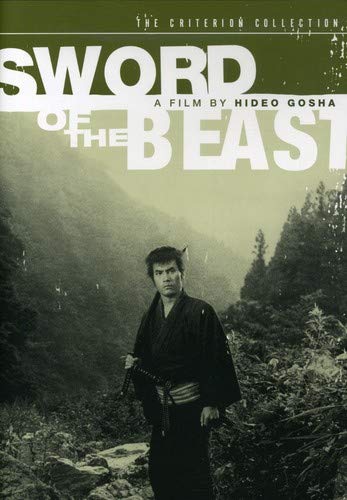subtítulos en español (traducción by Allzine) --> descarga desde ETscylla en FH escribió:Hideo Gosha - Kedamono no ken (1965)
Samurai Gold Seekers
Sword of the Beast
IMDb
Criterion
DVD VerdictA man of honor struggles to regain his good name after being exiled to the wrong side of the law in this period drama from Japan. Gennosuke (Mikijiro Hira) was a loyal swordsman hoping to gain a position of power in his clan when he killed a man on orders of one of his superiors. After committing the foul deed, Gennosuke discovers he's been betrayed by his masters; bitter and disillusioned, Gennosuke becomes a ronin, a samurai without a ruler, and pledges to wander the Earth like an animal. While on the run from his former associates, Gennosuke falls in with a band of outlaws who are poaching gold that belongs to the shogun. Among the criminals, Gennosuke discovers a man who may be able to restore him to a position of respect, but the ronin discovers the man is not to be trusted, a situation that becomes all the more complicated when he becomes infatuated with his wife. Sword of the Beast (aka Kedamono no ken) was the second feature film from Hideo Gosha, who went on to become one of Japan's leading directors of samurai cinema. — Mark DemingCódigo: Seleccionar todo
ÛÛÛ² PRESENTS: SWORD OF THE BEAST (1965) ÛÛÛ± ° Kedamono No Ken ÛÛÛÛ ÛÛÛÛ MOViE iNFORMATiON ÛÛÛÛ ÛÛÛß [ THEATRE DATE....: 1965 ÛÛÛÛ [ RELEASE DATE....: 10/9/2005 ÛÛÛÛ [ STORE DATE......: 10/25/2005 ÛÛÛÛ° [ GENRE...........: Action/Samurai Drama ÛÛÛÛ [ RATiNG..........: 6.9/10 (9 votes) ßÛÛÛ [ NO. SCREENiNGS..: ??? ÛÛÛÛ° ²ÛÛÛÛ [ RUNTiME.........: 85 Minutes ßÛÛÛ° [ ViDEO BiTRATE...: 1058 kBit/s XviD at 23.976FPS ÛÛÛÛ± [ AUDiO BiTRATE...: 80 kBit/s Mono MP3 at 48KHZ, JA ÛÛÛÛ± [ ASPECT RATiO....: 2.35:1 ÛÛÛÛ² [ RESOLUTiON......: 640x272 ÛÛÛÛ² [ ARCHiVES........: sph-sotb.rar *50x15* ²ÛÛÛÛ [ AVi SiZE........: 700 MB * 717,802 KB * 35,029,248 B ÛÛÛÛ² [ SUBTiTLES.......: ENSword.of.the.Beast.1965.DVDRip.XviD-SAPHiRE.avi
Sword.of.the.Beast.1965.DVDRip.XviD-SAPHiRE.rar
Sword.of.the.Beast.1965.DVDRip.XviD-SAPHiRE.nfo
I Wish I Could Be a Beast
- Patrick Macias
Yasukuni Temple, not far from the Imperial Palace, in Tokyo . . . the spirits of dead warriors are said to reside there. Yasukuni is a Shinto shrine, built in 1869 to honor those who died in Japan’s military service. And because convicted war criminals are also buried there, Yasukuni has become a battleground unto itself. One appearance by the prime minister, to pray for the souls of the departed, and Japan’s relations with countries like China and South Korea go south. To them, Yasukuni is a reminder of the unresolved legacy of the bad old days—World War II, for instance.
Next to the shrine is the Yushukan, a war museum built in the modern Western style. Inside you’ll find actual Zero Fighter airplanes, cannon shells from the battleship Musashi, and bloodstained flags recovered from banzai charges. The Yushukan also houses a collection of swords from the samurai era. Behind glass, like animals at the zoo, these legendary weapons from the Sengoku and Tokugawa eras seem decidedly unromantic, mere tools for the will of the emperor, the shogun, warring clans and their officials—real but oddly devoid of humanity. But if you spend enough time in the museum mulling over these objects, you may begin to sense the ghosts around you, to wonder about the inner lives of the people who once wielded these swords. Did they obey their orders blindly and without doubt? Was their rank and status in Japanese society satisfactory to them? And what sort of energy did they need to fight and kill other human beings? Such inquiries are absent from the museum’s impersonal march through history. But these questions are central to the films of Hideo Gosha, and especially to Sword of the Beast (also known as Samurai Gold Seekers).
Gosha’s career was marked, from the beginning, by disreputable men clutching swords. Born in Tokyo, in 1929, he joined the Nippon Hoso radio company in 1953, and moved on to Fuji Television in 1959. He debuted as a director in 1962, with the television series Three Outlaw Samurai, and his first feature film, released two years later, was based on the series (and had the same name). He may be best known in Japan for his hit melodrama The Life of Hanako Kiruin (1982)—about a childless gang boss who adopts a young girl in early twenties Japan—but fans of period films (jidai-geki) place him among the very best talents ever to grace the genre, including Akira Kurosawa and Kihachi Okamoto.
sigue leyendo...

















